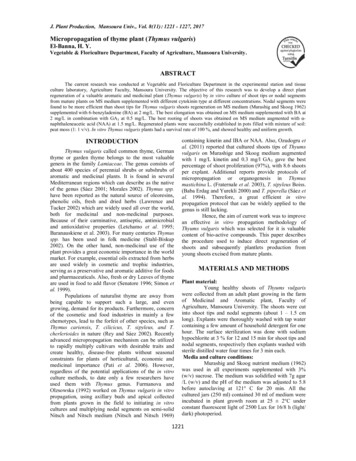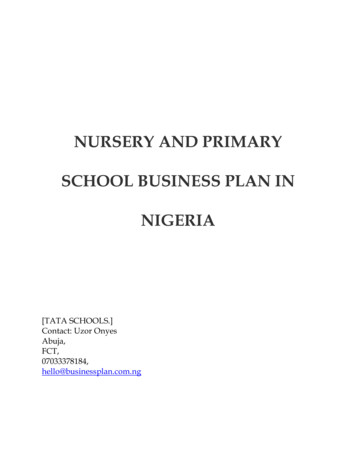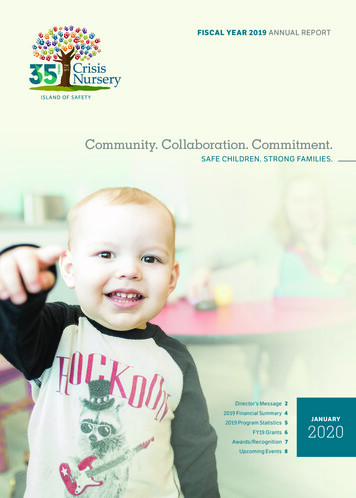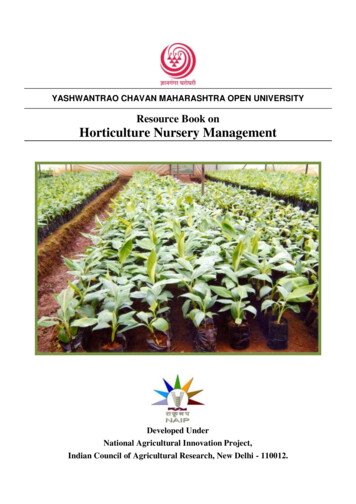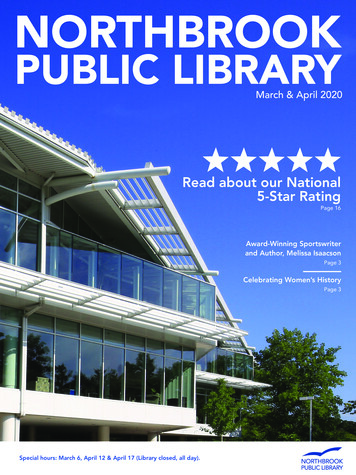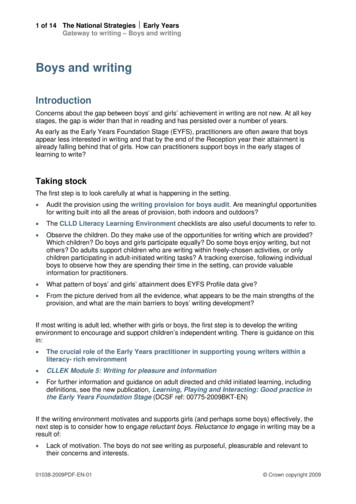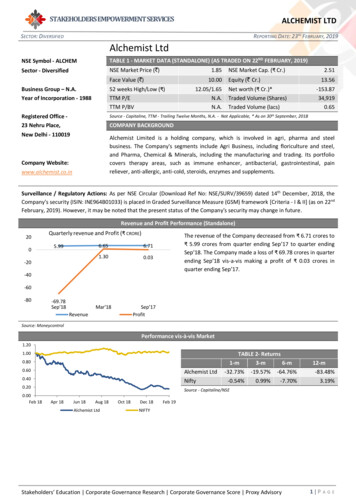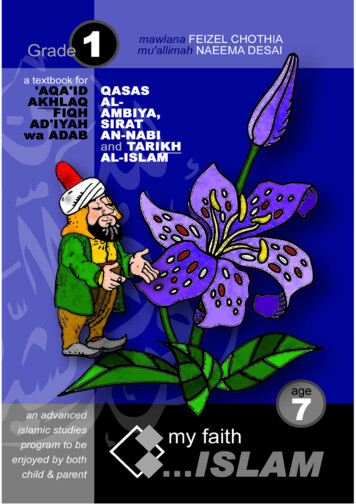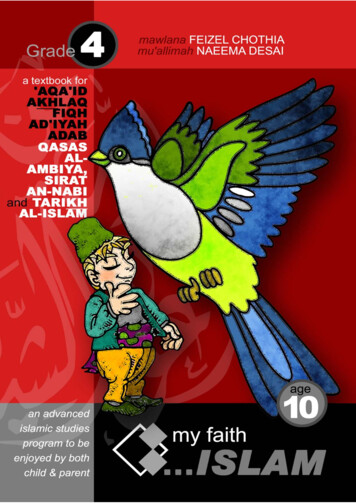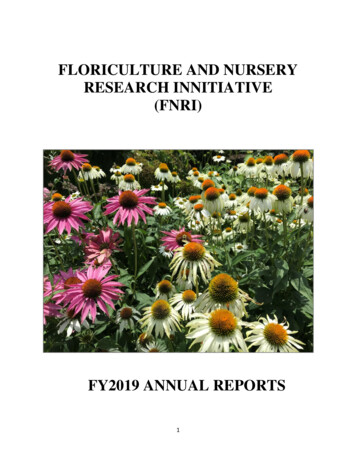
Transcription
FLORICULTURE AND NURSERYRESEARCH INNITIATIVE(FNRI)FY2019 ANNUAL REPORTS1
Floriculture and Nursery Research InitiativeFY 2019 Annual ReportsTABLE OF CONTENTSPageFNRI Summary1GERMPLASMGermplasm Resources for the Floriculture and Nursery Industry at theOrnamental Plant Germplasm Center (OPGC). [Pablo Jourdan]7BIOTECHNOLOGYBasic Mechanisms of Plant Metabolism: Biotechnology Approaches forManipulating Plant Biochemistry. [Robert Shatters and ThomasColquhoun]9Development of Transgene-free Approaches for Gene Editing inLandscape Plants. [Wusheng Liu, Thomas Ranney, Hamid Ashrafi,Darren Touchell, and Fred Gouker]12Development of a Novel Control Strategy for Thrips and Tospovirusesin Floral Crops. [Anna Whitfield, Thomas L. German, and Scott Adkins]13GREENHOUSE AND NURSERY PRODUCTION TECHNOLOGYAdvancing Pest Management in Floriculture Crops ThroughApplications of Innovative Technologies. [Christian Nansen and DanKluepfel]16Improved Pest Control Application Technologies for Sustainable CropProtection. [Heping Zhu]20Development of Technologies and Strategies for Sustainable CropProduction in Containerized and Protected Horticulture Systems. [ErikRunkle, Roberto Lopez, and James Altland]23Interactive Effects of Temperature and Photoperiod on Flower Initiationand Development. [James Faust and James Altland]24Resilient Plants: Production, Shipping and Postharvest Techniques toMaximize Sales and Sell-Through While Minimizing Inputs (includinglabor). [Paul Fisher and James Altland]26Resilient Plants: Production, Shipping and Postharvest Techniques toMaximize Sales and Sell-Through while Minimizing Inputs (includinglabor). [John Erwin and James Altland]292
TABLE OF CONTENTS continuedPageRe-engineering Growing Media to Reduce Water, Agrochemical Inputs,& Crop Stress to Minimize Time to Market. [Jim Owen and JamesAltland]31Strategies and Technologies to Optimize Resources in ControlledEnvironment Agriculture. [Ariana Torres, Rosa Raudales, DewayneIngram, and Jennifer Boldt]33Using Degraded Water Resources for Irrigation in the Production ofHorticultural Crops. [Chris Wilson and Joseph Albano]34Improving the Efficiency of Container Substrates: Developing Waterand Nutrient Profiles. [Brian Jackson and Joseph Albano]35Alternative Irrigation Water Sources for Sustainable Nursery Productionand Urban Landscapes. [Raul Cabrera, Genhua Niu, and James Altland]36ECONOMICS AND IMPACTSEvaluation of Native and Underutilized Germplasm for Nursery andLandscape Use. [Nick Gawel and Lisa Alexander]39Resilient Plants: Production, Shipping and Postharvest Techniques toMaximize Sales and Sell-Through while Minimizing Inputs. [CharlieHall and James Altland]41Strategies for Carbon Sequestration and Reducing Greenhouse GasEmissions from Nursery Production Systems. [Stephen Prior, BrettRunion, Anna-Marie Murphy, Dave Williams, and Allen Torbert]No Report-PESTS AND WEEDSNew Strategies for Management of Invasive Ambrosia Beetles inHorticultural and Nursery Crops. [Peter Schultz, Jason Oliver, KarlaAddesso, Chris Ranger, and Mike Redding]47Evolving and integration of management plans for major taxonomicgroups and potential new invasive pests of ornamental and floricultureproduction. [Lance Osborne and Cindy McKenzie]53Identification of Methods for Quarantine Certification of Imported FireAnt in Nursery Production Systems and Establishment of BiologicalControl Agents to Reduce Fire Ant Populations. [Jason Oliver, KarlaAddesso, and Lisa Alexander]57Maximizing Weed Control in Container Nurseries: The Next 30 Years.[Chris Marble and James Altland]613
TABLE OF CONTENTS continuedPageDISEASEImproved Pathogen Detection and Management of Bulb Diseases. [GaryChastagner and Dilip Laksham] No Report-Discovery and Management of Diseases of Floriculture Crops. [MargeryDaughtrey and Melanie Filiatrault]64Integrated Disease Management of Exotic and Emerging Plant Diseasesof Horticultural Crops. [Nik Grunwald, Jerry Weiland, and CarolynScagel]67Isolation, Identification, and Management of Phytophthora Species inNurseries and Greenhouses. [Steven Jeffers]70Monitoring and Molecular Characterization of Pythium Species inFloricultural Greenhouses of NY and OK. [Carla D. Garzon]73New Technologies that Manage Profit-Limiting Diseases with a Focuson Botrytis. [Mary Hausbeck]75Filling the Gaps in Boxwood Blight Research. [Marc Cubeta, NinaShishkoff, Jerry Weiland, and , Jo Anne Crouch]784
SUMMARYThe purpose of this report is to compile and update the yearly progress made by researchdirected by the Floral and Nursery Initiative funds located at USDA-ARS headquarters.History of USDA-ARS Floriculture and Nursery Research Initiative (FNRI)The ARS Floriculture and Nursery Research Initiative (FNRI) was presented to congress in1998 by the American Nursery Landscape Association and Society of American Florists(SAF). The initiative was the culmination of five years of surveys and discussion among thegreen industry, academic researchers, and USDA Agricultural Research Service (ARS) toidentify priority research goals and key projects in environmental horticulture. FNRI was firstfunded in FY 1999 with 1 million in congressional appropriated funding to ARS. Since thattime there have been six additional funding increases for more than 6 million, although actualappropriated dollars have been adjusted for rescissions, sequestration, and other changes tofederal base funding. FNRI uses a model of tripartite coordination between ARS Office ofNational Programs, commodity groups (AmericanHort and SAF), and university cooperatorsto set research priorities each year. Over the years, some FNRI funds have been moved to ARSbase funds in order to hire permanent ARS scientists for FNRI objectives, mostly at the U.S.National Arboretum (USNA). The remaining funds are distributed to floral and nurseryresearchers on a yearly basis as determined by ARS Office of National Programs inconsultation with AmericanHort and SAF. ARS leads floriculture and nursery researchprojects at 22 locations in the U.S. representing more than 37 million in ongoing researchefforts. FNRI funding represents a substantial portion of the overall ARS efforts and a uniquepublic-private partnership funded through ARS. FNRI plays a critical role in generatingscientific research on high-priority issues that affect all segments of the floral and nurseryindustries including post-harvest technology, water quality and pest and disease management.In FY2019, the total amount allocated for FNRI at ARS headquarters was 2,862,590. Thisamount does not include FNRI funding that has been converted in ARS base funds.FNRI-funded researchers presented their results in FY 2019 at: Scientific Conferences and Workshops 85 times (78 times in FY 2018)Grower Expos, Training, and Educational Workshops 48 times (47 times in FY 2018)Master Gardeners and Garden Clubs 4 times (6 times in FY 2018)Of these presentations, 9 were made outside the U.S. (17 in FY 2018)FNRI-funded researchers published their results in FY 2019 in: Peer-reviews journals 89 times (42 times in FY 2018) 10 additional manuscripts were submitted for publication 6 peer-reviewed Proceedings and Abstracts (7 in FY 2018) 20 Popular Press articles, Newsletters, Blogs, and Reference Guides (15 in FY 2018) 5 Books (4 in FY 2018) 2 Dissertations (1 in FY 2018) 1 online extension course for professional development1
o FNRI funding was used to train 28 graduate students and postdocs, as well as fund 44undergraduate and technical help in FY 2019. Five (5) international visiting scientistswere funded in part by FNRI and an additional four international experts participating in FNRIresearch without FNRI funding. Sixteen (16) undergraduate students and 9 graduate studentsand postdocs participated in FNRI research without receiving funding.o FNRI funding is currently being leveraged for 2.534 million competitive grants andunrestricted funding ( 2.375 million in FY 2018).o FNRI research is being conducted with a network of 121 growers, researchers, andcompanies not listed in these reports (102 in FY 2018)FY 2019 FNRI Funding went to ARS and university scientists for research on the projectssummarized below.Germplasm Collections and Evaluations, 340,0001. Pablo Jourdan, Department of Horticulture and Crop Science, at The Ohio StateUniversity, Columbus, OH and James Altland, ARS at Wooster, OH. The project istitled “Germplasm resources for the floriculture and nursery industry at the OrnamentalPlant Germplasm Center (OPGC)” and the goals are to acquire, document, maintain,characterize, and distribute herbaceous ornamental genetic resources and associatedinformation for conservation and scientific research.Biotechnology, 283,7981. David Clark and Thomas Colquhoun from the University of Florida and Bob Shatters,ARS, Ft. Pierce, FL. The project is titled “Basic Mechanisms of Plant Metabolism:Biotechnology Approaches for Manipulating Plant Biochemistry”. The project focuseson Lilium and Caladium to understand plant metabolism and the production offragrance, and to manipulate plant metabolism through environmental effects or geneediting. This project was evaluated in FY2020 and will transition to a new ARS PI,Joe Patt, in order to focus on the scent research with Thomas Colquhoun.2. Wusheng Liu, Thomas Ranney, Hamid Ashrafi, and Darren Touchell at North CarolinaState University, and Fred Gouker, ARS, Beltsville, MD. The project it titled“Development of transgene-free approaches for gene editing in landscape plants”. Theprojects focuses on developing DNA- free genome editing techniques to avoid thepresence of transgenes. New in FY 20193. Anna Whitfield, North Carolina State University; Thomas L. German, University ofWisconsin; and Scott Adkins, ARS, Fort Pierce, FL. The project is titled "Developmentof a Novel Control Strategy for Thrips and Tospoviruses in Floral Crops". The goal ofthis project is to develop new and effective technologies for management of tomatospotted wilt virus, including altered Bt toxins that are effective against the westernflower thrips insect, which moves the virus around, and dsRNA technologies. Thisproject was evaluated in FY2020.2
Greenhouse and Nursery Production Technology, 787,0001. Christian Nansen, University of California, Davis and Dan Kluepfel, ARS, Davis, CA.The project is titled “Advancing Pest Management in Floriculture Crops ThroughApplications of Innovative Technologies”. The project improves monitoring fordetection and diagnosis of emerging arthropod pest outbreaks using images, machinelearning, and robotics. It also tests novel chemistries and best practices in floral andnursery production.2. Heping Zhu, ARS, Wooster, OH. The project is titled “Improved Pest ControlApplication Technologies for Sustainable Crop Protection”. The goal of this project isoptimize an intelligent-decision air-assisted spraying system to increase pesticideapplication efficiency and minimize environmental impact for ornamental nurserycrops.3. Erik Runkle and Roberto Lopez, Michigan State University, and James Altland, ARS,Wooster, OH. The project is titled “Using Lighting Technologies and Genetics toImprove Growth and Flowering of Floriculture Crops”. The goal of this project is tounderstand the impact of blue light and far-red radiation on growth attributes andsubsequent flowering of common annual bedding plant seedlings grown indoors anddetermine LED supplemental lighting.4. James Faust, Clemson University and James Altland, ARS, Wooster, OH. The projectis titled “Optimizing Water Use in Floriculture Crops”. The goal of this project is toreduce water use in propagation of vegetative annuals for the purpose of improvedenvironmental stewardship and improved production efficiency.5. Paul Fisher, University of Florida and James Altland, ARS, Wooster, OH. The projectis titled “Resource Efficiency in the Floriculture Production and Value Chain”. Thegoal of this project is produce grower decision support tools that improve resource useefficiency at each step of production and distribution of floriculture crops frompropagation of the seed or unrooted cutting to a finished plant at retail.6. John Erwin, University of Minnesota and James Altland, ARS, Wooster, OH. Theapplied focus of the work is to reduce energy inputs, reduce labor inputs, improve cropyield via environmental manipulation, and reduce chemical inputs by combiningchemicals to produce synergistic responses.7. Jim Owen, Virginia Polytechnic Institute and State University, and James Altland,ARS, Wooster, OH. The project is titled “Development of Technologies and Strategiesfor Sustainable Crop Production in Containerized and Protected Horticulture Systems”.Research supports new pine-based substrates for container nursery production that areengineered to reduce water use, lower agrochemical inputs, and minimize crops stressand time to market. New in FY 20198. Ariana Torres, Purdue University; Rosa Raudales, University of Connecticut; DewayneIngram, University of Kentucky; and Jennifer Boldt, ARS Toledo, OH. The project istitled “Strategies and technologies to optimize resources in controlled environmentagriculture”. This project proposes to measure energy, water, carbon, and nutrientbenchmarks for growers to compare resource efficiency at their operations with that ofthe industry and competitors using data collected from commercial greenhouses.Benchmarks will help growers evaluate their internal use of resources and3
environmental impact (using the Water Footprint model and Life Cycle Assessment).New in FY 20199. Chris Wilson, University of Florida; and Joseph Albano, ARS, Fort Pierce, FL. Theproject is titled “Using Degraded Water Resources for Irrigation in the Production ofHorticultural Crops”. The goal of this project is to support ongoing specialty cropsresearch focused on plant nutrition and fertilizers, irrigation method and water quality,substrate composition and chemistry, and runoff water remediation. This project wasevaluated in FY2020 and, given the other funding that is now available, will not befunded by FNRI in FY 2020.10. Brian E Jackson, North Carolina State University, Raleigh, NC; and Joseph P. Albano,ARS, Fort Pierce, FL. The project is titled “Improving the Efficiency of ContainerSubstrates: Developing Water and Nutrient Profiles”. The goal of this research is toidentify the optimal pulse regimen for sub-irrigation practices on horticulturalsubstrates as well as determine how height of water and moisture content affect asubstrates hydration efficiency. This project was evaluated in FY2020 and, given theother funding that is now available, will not be funded by FNRI in FY2020.11. Raul Cabrera, Rutgers University; Genhua Niu, Texas A&M AgriLife Research; andJames Altland, ARS, Wooster, OH. The project is titled “Alternative Irrigation WaterSources for Sustainable Nursery Production and Urban Landscapes”. The goal of thisproject is to evaluate the effects of using reclaimed water and graywater for nursery &greenhouse crop irrigation as compared to municipal potable or high-quality watersources. . This project was evaluated in FY2020 and, given the other funding that isnow available, will not be funded by FNRI in FY 2020.Economics and Impacts, 205,7921. Nick Gawel, Tennessee State University, McMinnville, TN, and Lisa Alexander, ARS,McMinnville, TN. The project is titled “Evaluation of native and underutilizedgermplasm for nursery and landscape use”. Research includes replicated trials todevelop, and evaluate improved germplasm of species native to the Southeastern US toexpand market opportunities and decrease the environmental footprint of nurseryproduction. Evaluations will emphasize disease incidence and tolerance, productionvalue, ornamental merit, and potential for breeding improvement. New in FY 20192. Charlie Hall, Texas A&M University, and James Altland, ARS, Wooster, OH. Theproject is titled “Measuring Economic Efficiency in the Floriculture Production ValueChain”. Research goals are to determine the morphological, physiological, quality, andeconomic responses of four bedding plant species to reduced substrate moisturecontent.3. Stephen Prior, Brett Runion, and Allen Torbert, ARS, Auburn, AL, Anna-MarieMurphy and Dave Williams, Auburn University. The project is titled "Strategies forCarbon Sequestration and Reducing Greenhouse Gas Emissions from NurseryProduction Systems". The goal of this project is to determine baseline greenhouse gasemissions for nursery systems, develop strategies to reduce emissions, and developstrategies to increase soil carbon storage. No Report4
Pests and Weeds, 427,0001. Peter Schultz, Virginia Tech, Jason Oliver and Karla Addesso, Tennessee StateUniversity with Chris Ranger and Mike Redding, ARS, Wooster, OH. The project istitled “New Strategies for Management of Invasive Ambrosia Beetles in Horticulturaland Nursery Crops”. The goal of this project is to adjust production practices tomaximize tree health and minimize the risk of ambrosia beetle attacks by usingrepellents to push beetles away from vulnerable trees and attractants to pull beetles intoannihilative traps.2. Lance Osborne, University of Florida and Cindy McKenzie, ARS, Fort Pierce, FL. Theproject is titled “Evolving and Integration of Management Plans for Major TaxonomicGroups and Potential New Invasive Pests of Ornamental and Floriculture Production”.The goal of this project to evaluate alternatives to neonicotinoid class of insecticides byworking closely with the chemical industry to identify registered pesticides and thosenear registration that could fill the void created if the neonicotinoid class is banned.3. Jason Oliver and Karla Addesso, Tennessee State University, and Lisa Alexander,ARS, National Arboretum, McMinnville, TN. The project is titled “Identification ofMethods for Quarantine Certification of Imported Fire Ant in Nursery ProductionSystems and Establishment of Biological Control Agents to Reduce Fire AntPopulations”. The goal of this project is to develop new treatment options for thecontrol of red imported fire ants that have lower cost, longer certification periods, rapidapplication potential, and less worker exposure.4. James Altland, ARS, Wooster, OH. The project is titled “Weed Management Strategiesto Reduce Costs, Improve Control, and Mitigate Injury to Sensitive Crops”. The goalof this project is to develop new strategies for growers to deal with the decliningefficacy of traditional herbicides for weed control. In FY2019 this project expanded toinclude Chris Marble, University of Florida.Disease, 819,0001. Gary Chastagner, Washington State University, and Dilip Laksham, ARS, Beltsville,MD. The project is titled “Improved Pathogen Detection and Management of BulbDiseases”. The goal of this project is to provide growers with the necessary tools tomanage gray mold. Researhc is focused on a better understanding of the diversity ofBotrytis species, their pathogenicity and biology, source of inoculum, and sensitivity tofungicides to improve Botrytis disease management programs. This project wasevaluated in FY2020. No Report2. Margery Daughtrey, Cornell University, Riverhead, NY; and Melanie Filiatrault, ARS,Ithaca, NY. The project is titled “Discovery and Management of Diseases ofFloriculture Crops”. This project is focused on molecular population analyses toidentify, monitor, and describe new, emerging bacterial pathogens in commercialgreenhouses.3. Nik Grunwald, Jerry Weiland, and Carolyn Scagel, ARS, Corvallis, OR. The project istitled “Improving plant health for nursery production in the Pacific Northwest”. ThePacific Northwest nursery industry produces stock in both containers, and fieldoperations. The goal of this project is to prevent Phytophthora and Pythium infectionthrough an integrated approach to plant pathology, genomics and marker development,5
4.5.6.7.and soil health and nutrient management.Steven Jeffers, Clemson University; Carla Garzon, Oklahoma State University; andStewart Gray, ARS Ithaca, NY. The project is titled “Tracking and Managing Diseasesof Floriculture Crops Caused by Oomycetes and Fungi”. In collaboration with the USLavender Growers Association, the project focuses on phytophthora root and crown roton lavender and root knot nematodes impacting field-grown lavender, and Pythiumroot rot in chrysanthemums and poinsettias. This project will transition to new ARSPIs (Weiland and Grunwald) in FY 2020 due to the retirement of Stewart Gray(ARS, Ithaca, NY).Carla D. Garzon, Oklahoma State University, OK. The project it titled “Monitoring andMolecular Characterization of Pythium species in Floricultural Greenhouses of NY andOK”. The goal of this research is to assess the incidence and diversity of pathogenicPythium species in floricultural crops grown outdoor (chrysanthemum) and indoor(poinsettia, dahlia) on the same season; and monitor the movement of inoculumbetween outdoor and indoor crops grown simultaneously in the same floriculturaloperations. This project will transition to new ARS PIs (Weiland and Grunwald) inFY 2020 due to the retirement of Stewart Gray (ARS, Ithaca, NY).Mary Hausbeck, Michigan State University and Stewart Gray, ARS Ithaca, NY. Theproject is titled “Employing New Tools to Detect and Limit Phytophthora Root Rot,Downy Mildew, and Other Key Pathogens of Floral Crops”. The goal of this project isto determine disease susceptibility among cultivars of seed-geraniums and snapdragonsto Pythium, determine the host range and virulence of Pythium species that may infectgreenhouse floral crops, and characterize the efficacy of new active ingredients,including reduced-risk fungicides, biocontrol agents or biopesticides. This project willtransition to new ARS PIs (Weiland and Grunwald) in FY 2020 due to the retirementof Stewart Gray (ARS, Ithaca, NY).Jo Anne Crouch, ARS, Beltsville, MD; Nina Shishkoff, ARS, Frederick, MD; JerryWeiland, ARS, Corvallis, OR; and Marc Cubeta, North Carolina State University. Theproject is titled "Minimizing the Impact of Boxwood Blight Disease". The goal of thisproject is to understand the causal agent for boxwood blight and develop controlstrategies. In FY2019 this project expanded to include Jerry Weiland, ARS,Corvallis, OR.Projects not included in the FY2019 FNRI Report The Commercial Floriculture Survey was conducted by the National Agricultural StatisticsService (NASS) and provides the number of growers, area of production, quantity sold,percent of sales at wholesale, wholesale prices, wholesale value of production forfloriculture commodities, and average number of agricultural workers per farm or ranch.FY 2018 was the only year of funding for this project.David Norman, University of Florida, Apopka and Qi Huang, ARS, Beltsville, MD. Theproject is titled “Host Pathogen Interaction of Cool Tolerant Bacterial Wilt Strains”. FY2018 was the last year of funding for this project.Caitilyn Allen, University of Wisconsin and Qi Huang, ARS, Beltsville, MD. The projectis titled “Biology & Pathogenesis of Ralstonia solanacearum Race 3 on Geraniums &Other Hosts”. FY 2018 was the last year of funding for this project.6
Germplasm resources for the floriculture and nursery industry at the Ornamental PlantGermplasm Center (OPGC)Pablo Jourdan, Department of Horticulture and Crop Science, The Ohio State University,Columbus, OHBackground: Genetic resources are fundamental for continued development of ornamentalcrops. Availability of such resources is critical for the success of the industry. The project isdesigned to provide genetic resources for the Floriculture and Nursery industry throughsupport of the Ornamental Plant Germplasm Center, whose mission is to acquire, document,maintain, characterize, and distribute herbaceous ornamental genetic resources and associatedinformation for conservation, enhancing scientific research and the industry. The objectivesthat permit us to fulfil our mission include:1. Acquisition of appropriate germplasm of priority genera. Our goal is to havecomprehensive collections of the current priority genera, especially the NorthAmerican native species (in Coreopsis, Lilium, Phlox and Rudbeckia), by regularexploration/collection expeditions to obtain wild material with the greatest possiblediversity.2. Maintenance of current collections through appropriate seed increases of the mostcritical accessions. Establishment of virus-free material of our clonal collections,especially in Begonia and Pelargonium, for back-up purposes and to ensure that weonly distribute clean material.3. Comprehensive characterization of our collections in the priority genera to provideusers of our germplasm with information that could benefit breeding programs4. Expand collaboration with industry representatives in identifying desirable andaccessible public- domain germplasm and in promoting the use of our currentgermplasm.Progress and Accomplishments in FY 2019Clonal collection: We are continuing to establish clonal accessions in tissue culture andresearch on strategies to increase time interval between in vitro subcultures continues,including cold storage, osmoticum adjustment (addition of sorbitol, higher levels of sucrose),light quality, and vessel sealing methods. These have been a major focus of our efforts overthe past year. The table below shows the number of accessions currently in tissue culture; 20Cis the base collection, and some accessions are being replicated in 4/10C in an attempt to slowgrowth:Genus20C 10C ous 10107
Distribution of germplasm continues to be an important activity; 81 germplasm requests and591 order items were distributed the past year. Since the OPGC began distributing germplasmin 2002, 1,421 orders and 9,705 germplasm items have been distributed. An additional 61non-research requests were received within the last year, representing 43% of all germplasmrequests.Acquisitions: 1,291 accessions were acquired in the past year, including 1,286 accessionscollected through the Seeds of Success program of the Bureau of Land Management.Accessions: Currently 6,779 accessions are maintained at the OPGC. Approximately 35% ofthe collection is available for distribution; 4,394 accessions are backed up off-site (65% of thecollection). Seed viability of 80 accessions was tested last year. Seed of 52 begoniaaccessions were grown for confirmation of consistent taxonomy of the progeny (no accidentalcontaminations.FY 2019 PublicationsJourdan, P. (2018). Short- and medium-term in vitro conservation and management ofgermplasm within the USDA's National Plant Germplasm System. Acta Hortic. 1224, 3138DOI: 17660/ActaHortic.2018.1224.5Ji Hee Kim and Jeung Keun Suh, Seong-Tak Yoon, Pablo Jourdan, Mark S. Roh (2018)Germination of Fully Developed Corylopsis Seeds Influenced by Harvest Date and ColdStratification HORTSCIENCE 53(9):1360–1363. an P (2019) Herbaceous Ornamentals. In: Green S, Williams K, Marek L, Kantar M,Khoury C. eds. North American Crop Wild Relatives: Conservation and Use. Volulme 2:607-643 Springer. https://doi.org/10.1007/978-3-319-97121-6 188
Basic Mechanisms of Plant Metabolism: Biotechnology Approaches for ManipulatingPlant BiochemistryThomas A. Colquhoun, Associate Professor, UF/IFAS, Gainesville, FLRobert Shatters, Research Molecular Biologist, USDA-ARS, Ft. Pierce, FLBackground: Floral fragrance is lacking in many floriculture crops, but industry andconsumers alike desire elevated levels and quality of floral fragrance. Our research has astrong foundation in biochemistry and molecular biology with two principal concentrations:elucidation/manipulation of plant metabolism and genetic engineering of plants. The long-termgoal is to intimately understand the complex mechanisms plants use to change thebiochemicals they produce under different environments. This research spans the basic andapplied nature of floriculture from elucidating biochemical mechanisms in flower tissue toaiding plant breeders in generating flowers with fragrances consumers like. Graduate andundergraduate student mentoring is a high priority in our scientific program.We currently have four research projects with potential high impact:1.2.3.4.Lilium flower differential RNA-seq/volatilome.Caladium floral biosynthesis of the volatile molecule 4-methyl-5-vinylthiazole.Manipulation of plant metabolism/physiology with narrow-bandwidth lighting.Development of CRISPR/Cas systems for modifying important horticultural plants.Progress and Accomplishments in FY 2019: Lilium flower differential RNA-seq/volatilome - We chose to perform a differentialtranscriptomic sequencing (RNA-seq) study with floral tissue from the same fivecultivars used in Johnson et al., 2016 and in collaboration with the UF InterdisciplinaryCenter for Biotechnology Research. A reference transcriptomic sequence (RefSeq) wasgenerated and annotated. Approximately 150,000 unique sequences were identified.The RefSeq was then used as a scaffold for the assembly of quantitative Lilium floraltranscriptomes. After data quality control, assembly, annotation, and analyses a total ofapproximately 45,000 unique transcripts were quantitatively identified. Weighed geneco-expression network analysis using the differential transcriptomics data identified 30transcript accumulation trends between cultivars. Correlation of these transcriptomictrends with volatile metabolomics data is enabling the identification of genotypespecific transcripts associated with cultivar specific fragrance production in Lilium.Leveraging the dual dimensionality of our data set (cultivar by transcript andmetabolomics) provides a path to construct our initial understanding of the biochemicalsteps underlying volatile biosynthesis in Lilium.Caladium floral biosynthesis of the volatile molecule 4-methyl-5-vinylthiazole Through a collaborat
detection and diagnosis of emerging arthropod pest outbreaks using images, machine learning, and robotics. It also tests novel chemistries and best practices in floral and nursery production. 2. Heping Zhu, ARS, Wooster, OH. The project is titled "Improved Pest Control Application Technologies for Sustainable Crop Protection".
